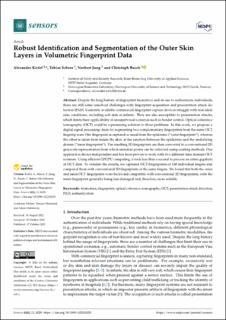| dc.contributor.author | Kirfel, Alexander | |
| dc.contributor.author | Scheer, Tobias | |
| dc.contributor.author | Jung, Norbert | |
| dc.contributor.author | Busch, Christoph | |
| dc.date.accessioned | 2023-01-20T09:02:32Z | |
| dc.date.available | 2023-01-20T09:02:32Z | |
| dc.date.created | 2022-11-28T10:17:43Z | |
| dc.date.issued | 2022 | |
| dc.identifier.citation | Sensors. 2022, 22 (21), . | en_US |
| dc.identifier.issn | 1424-8220 | |
| dc.identifier.uri | https://hdl.handle.net/11250/3044843 | |
| dc.description.abstract | Despite the long history of fingerprint biometrics and its use to authenticate individuals, there are still some unsolved challenges with fingerprint acquisition and presentation attack detection (PAD). Currently available commercial fingerprint capture devices struggle with non-ideal skin conditions, including soft skin in infants. They are also susceptible to presentation attacks, which limits their applicability in unsupervised scenarios such as border control. Optical coherence tomography (OCT) could be a promising solution to these problems. In this work, we propose a digital signal processing chain for segmenting two complementary fingerprints from the same OCT fingertip scan: One fingerprint is captured as usual from the epidermis (“outer fingerprint”), whereas the other is taken from inside the skin, at the junction between the epidermis and the underlying dermis (“inner fingerprint”). The resulting 3D fingerprints are then converted to a conventional 2D grayscale representation from which minutiae points can be extracted using existing methods. Our approach is device-independent and has been proven to work with two different time domain OCT scanners. Using efficient GPGPU computing, it took less than a second to process an entire gigabyte of OCT data. To validate the results, we captured OCT fingerprints of 130 individual fingers and compared them with conventional 2D fingerprints of the same fingers. We found that both the outer and inner OCT fingerprints were backward compatible with conventional 2D fingerprints, with the inner fingerprint generally being less damaged and, therefore, more reliable. | en_US |
| dc.language.iso | eng | en_US |
| dc.publisher | MDPI | en_US |
| dc.rights | Navngivelse 4.0 Internasjonal | * |
| dc.rights.uri | http://creativecommons.org/licenses/by/4.0/deed.no | * |
| dc.title | Robust Identification and Segmentation of the Outer Skin Layers in Volumetric Fingerprint Data | en_US |
| dc.title.alternative | Robust Identification and Segmentation of the Outer Skin Layers in Volumetric Fingerprint Data | en_US |
| dc.type | Peer reviewed | en_US |
| dc.type | Journal article | en_US |
| dc.description.version | publishedVersion | en_US |
| dc.source.pagenumber | 0 | en_US |
| dc.source.volume | 22 | en_US |
| dc.source.journal | Sensors | en_US |
| dc.source.issue | 21 | en_US |
| dc.identifier.doi | 10.3390/s22218229 | |
| dc.identifier.cristin | 2082164 | |
| cristin.ispublished | true | |
| cristin.fulltext | original | |
| cristin.qualitycode | 1 | |

